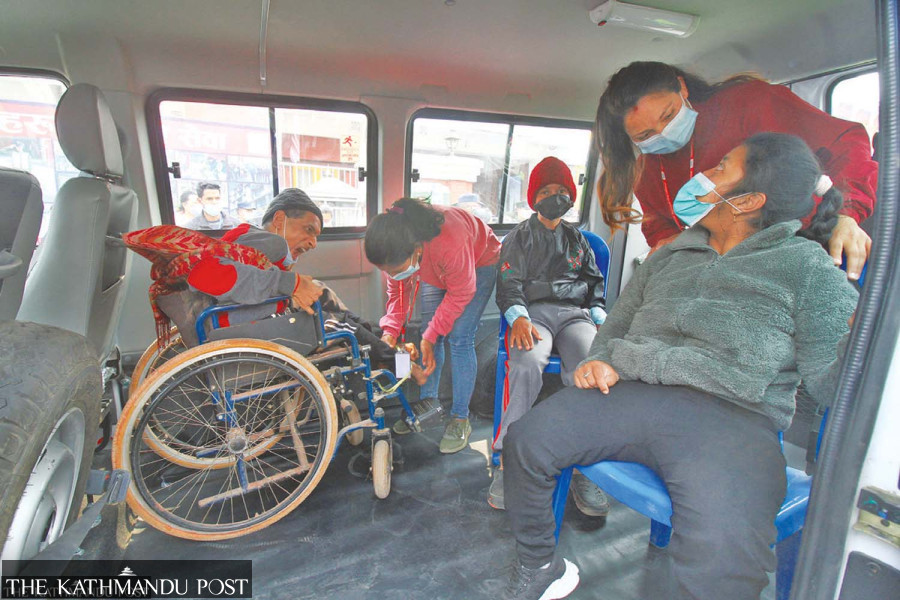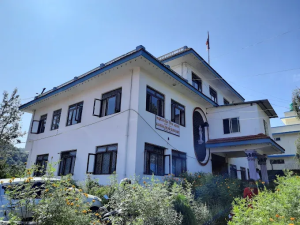Bagmati Province
Public transport in the Capital remains a nightmare for people with disabilities
Stakeholders stress arrangements of designated stops for those with disabilities.
Aarati Ray
Surakshya Paudel, a 31-year-old woman from New Baneshwar, has been navigating the streets of Kathmandu for years. While there have been some improvements over the years, bus travel remains a challenge for Paudel, who is visually impaired.
Three months ago, while trying to disembark from a bus in Koteshwar, she fell off after the driver hurriedly asked passengers to get off before the vehicle came to a complete stop. Paudel fractured her hand and sustained minor leg injuries.
“This happens often,” says Paudel. “Drivers and conductors rush because they fear fines or reprimands. Boarding and disembarking passengers with disabilities, or those in wheelchairs, takes time.”
It gets scarier still when buses compete to collect more passengers along the way.
As per Paudel, if there are buses behind, drivers start honking, and in crowded areas, many buses avoid stopping altogether when they see someone with a disability.
This is not unique to Paudel but affects people with disabilities across Nepal.
According to Savitree Shrestha, programme coordinator at the National Association of the Physically Disabled-Nepal (NAPD-Nepal), many people with disabilities, especially those who are visually impaired, report facing hassles when trying to board or leave buses. Drivers and conductors often either don’t stop or rush so much that passengers are forced to board or exit moving buses, which comes with grave safety risks.
When the Post spoke with a few drivers and conductors, they explained their haste is largely driven by traffic congestion and the pressure to avoid fines for prolonged stops.
Ved Prasad Ghimire, vice-president of the Nepal Transport Independent Workers Organisation in Bagmati Province, says: “It is our responsibility to ensure our services are accessible to people with disabilities, the elderly, and others who require assistance,” he said, claiming that the organisation has been working on it.
Ghimire says that helping passengers with disabilities requires extra time and care. However, the presence of other buses in the queue, heavy traffic, and pressure from traffic police often create a tense environment. “When we take time to assist, buses behind us start honking, and traffic police rush us,” he said.
This pressure has led to incidents where drivers are penalised or reprimanded for lingering.
According to Ghimire, some drivers are chided for taking time, and accused of delaying the process to fill up the bus.
“This conflict between traffic management and bus operations needs to be addressed,” Ghimire said.
The issue is especially pronounced in high-traffic areas like Koteshwar, the NAC-Tundikhel area, and New Baneshwor.
While Ghimire acknowledges the challenges faced by traffic police in managing congestion, traffic police offer a different perspective on the issue.
Senior Superintendent of Police Pramod Bohara, who is currently deputed at the Jawalakhel Traffic Division after serving at the Jagati traffic office, says, “We do not rush buses when people with disabilities or the elderly are boarding.
“The real challenge is that buses often stop for extended periods to pick up too many passengers, which causes delays. So, sometimes, there might be problems as it is our duty to ensure smooth traffic flow.”
“Every second and minute counts on the road,” adds Bohara.
There are also deeper challenges at play.
Suresh Rajbhandari, a 60-year-old disability activist from Bhaktapur, says, “Awareness has certainly improved but proper accessibility and full rights are still lacking.”
As a visually impaired individual, Rajbhandari encounters many challenges when trying to board and disembark buses. “Buses don’t stop at fixed locations, and their stops keep changing, making things for people like us.”
Buses often stop randomly, making them unsure of the direction of the footpath. Sometimes they stop near obstacles, says Rajbhandari who has been working through organisations like Nepal Association of the Blind (NAB), and Voice for Equal Opportunity, Bhaktapur.
The absence of proper pavements worsens the problem, often leading to falls or injuries.
Rajbhandari says extra time required for people with disabilities to board or alight is frequently met with frustration by others.
One of Rajbhandari’s big concerns is that visually impaired passengers often struggle to identify bus numbers or colours. “Travelling alone is a real challenge as conductors sometimes drop us at the wrong stop, or we accidentally board the wrong bus,” he explains.
For those with both visual and hearing impairments, this problem is even more acute, he adds.
The bus stairs are often poorly designed or curved, making it difficult for white cane users or wheelchair users to board.
Paudel shares this frustration. “Even when we show our disability cards, some conductors remain sceptical, particularly with visually impaired individuals whose eyes may not show obvious signs of impairment. They often question the validity of our condition.”
For Paudel, the importance of fixed bus stops remains a big concern.
She shares that in areas like Koteshwor and Ratnapark, people often have to board moving buses, and passengers are sometimes asked to disembark before the bus has come to a complete stop.
“Such practices increase the potential for accidents like the one that happened to me,” adds Paudel.
Article 9 of the Convention on the Rights of Persons with Disabilities (CRPD) mentions the importance of accessible physical environments, transport, and information systems. Likewise, the ‘Accessible Physical Infrastructure and Communication Services Directive, 2012’, mandates that public facilities, such as bus parks, and transport services be accessible to people with disabilities.
It also requires that new public transport vehicles be designed with accessibility in mind, offering incentives such as tax exemptions for disability-friendly vehicles.
“Despite all these laws and policies, support and law enforcement are still insufficient. Not all transport services are adapted to meet the needs of people with disabilities,” says Binita Regmi, chairperson of the NAPD Nepal.
“We’ve been organising programmes like public service announcements for buses and sensitisation campaigns with traffic authorities and bus organisations,” adds Regmi. “While we hope for progress, achieving real change will require support of both society and government.”
Rajbhandari stresses the arrangements of designated bus stops for people with disabilities. “But that seems unlikely in the near future. At the very least, current bus parks should be made disabled-friendly.”
Inside buses and bus parks, information is not accessible for those with visual, hearing, or intellectual disabilities.
Rajbhandari says buses could implement an announcement system to better inform blind and visually impaired passengers.
“Bus drivers, conductors, and fellow passengers need to show more empathy and understanding to improve the overall experience for those with disabilities,” says Paudel.
Ghimire thinks it would be ideal if the government designated specific areas for special stops or bus parks for people with disabilities. “This would allow buses to pick up and drop off passengers safely, without rush.”
Bohara seconds him. “Such spaces would make a difference in accommodating passengers and reducing congestion, making the process smoother and more efficient for everyone.”




 5.44°C Kathmandu
5.44°C Kathmandu












